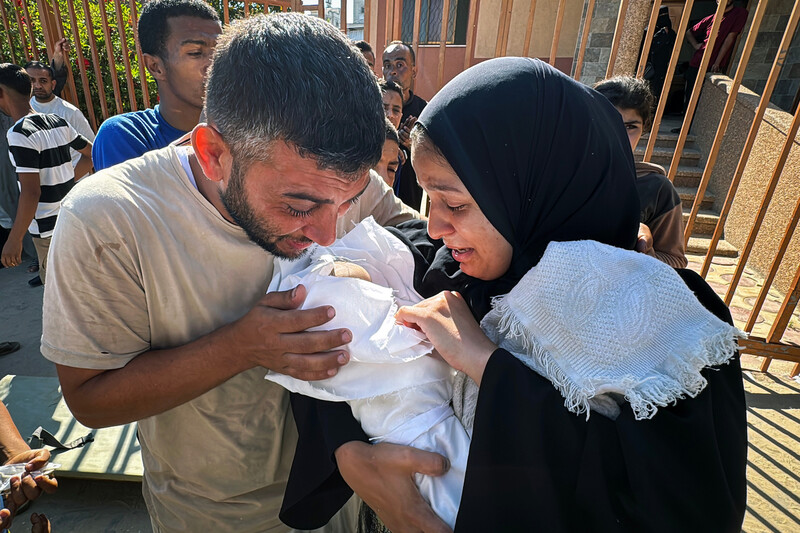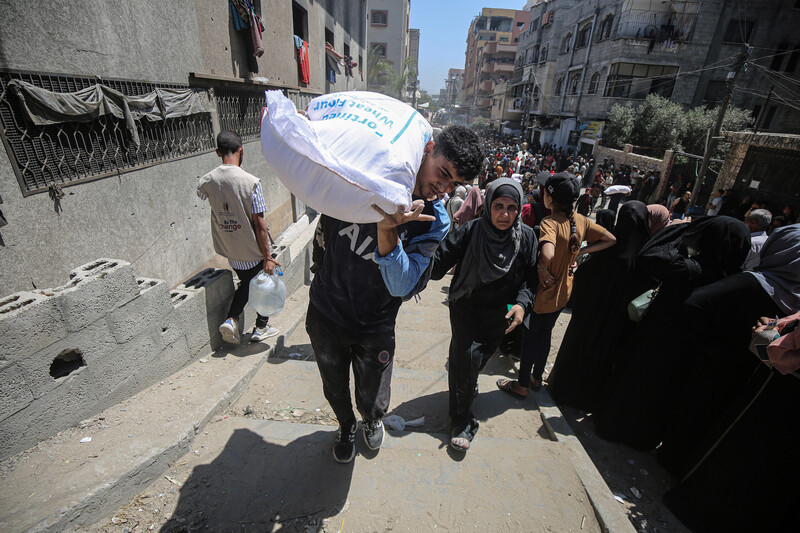Rights and Accountability 27 June 2025

A family mourns over the body of an infant who died of malnutrition outside Nasser Medical Complex in Khan Younis, southern Gaza, 26 June.
APA imagesWhether there will soon be a truce in Gaza is the big question after the US president unilaterally declared a ceasefire between Iran and Israel beginning on Tuesday, ending 12 days of confrontation.
While it attacked Iran, Israel carried on with its daily massacres in Gaza, targeting displaced people sheltering in tents and starving people attempting to reach food aid distribution points.
Israel killed nearly 900 Palestinians in Gaza during its unprovoked offensive in Iran, which left more than 600 people dead in that country. Twenty-eight people were killed in Iranian reprisal strikes in Israel.
Tel Aviv was keen to wrap up its failed gambit in Iran after incurring heavy losses, including the perforation of the reputation of its vaunted air defense systems.
Israel’s tax authority said the cost of property damage from Iranian strikes during the 12 days had exceeded $1.3 billion, around double the sum of compensation claims beginning on 7 October 2023.
Military pressure may help turn the tide in Gaza, too, after seven Israeli soldiers were killed by a fighter with the Qassam Brigades, the armed wing of Hamas, in a close-range ambush on a military vehicle in Khan Younis on Tuesday.
Video of the stunning ambush released by the Qassam Brigades on Wednesday shows a fighter carrying a rifle running towards the armored personnel carrier, upon which he climbs and drops a shawaz explosive device directly into the cabin. The recording shows the fighter safely withdrawing before the military vehicle becomes engulfed in flames.
“Pointless”
The mother of Niv Radia, a staff sergeant who was killed in the ambush, said that her son and the other soldiers who were killed were “just kids who finished their senior year and went straight into combat.”
“It feels so pointless, so many families have lost their children. This has to stop,” she told Israeli media.
Far more Palestinian families have been bereaved of their children – more than 17,000 boys and girls are among the 56,000 people and counting killed in Gaza – than Israeli families whose adult sons died while perpetrating a genocide. The Israeli military says it has lost 878 soldiers since 7 October.
The ambush in Khan Younis has triggered outrage among the Israeli public, which is generally indifferent to the unfathomable loss of life among Palestinians in Gaza but questions why soldiers are dying in a seemingly endless campaign – the longest in Israeli history.
In addition to opposition figures, even prominent members of Benjamin Netanyahu’s Likud party and coalition government are dissenting from the war on Gaza, with Moshe Gafni, a leading figure in the ultra-Orthodox party United Torah Judaism, saying “I don’t understand what we’re fighting for and for what purpose” after the deaths of the seven soldiers.
Most desperate phase
Increased pressure by Israeli public may be necessary to catalyze a change in policy by Netanyahu, who has been set on an amorphous goal of “total victory” in Gaza.
The diplomatic track towards a ceasefire in Gaza remains at a standstill, with Hamas consistent in its position that any agreement must ensure a permanent end to the war while Israel insists on its “right” to restart its military offensive.
According to an internal Hamas assessment obtained by Drop Site News, the only new factors in the equation are that Donald Trump has publicly expressed interest in leveraging the Iran ceasefire to reach an agreement in Gaza while domestic pressure is building in Israel following the Khan Younis ambush.
Hamas is under pressure too as Palestinians in Gaza endure what may be the most desperate phase of Israel’s campaign of annihilation.
More than 400 Palestinians have been killed while attempting to reach the Gaza Humanitarian Foundation food point since the American-Israeli militarized aid distribution scheme began operating on 27 March, according to the UN human rights office.
In addition, nearly 100 others have lost their lives while trying to approach the “very few aid convoys of the UN and other humanitarian organizations” allowed by Israel, the UN office added. “At least 3,000 Palestinians have been injured in these incidents.”
In an exposé published on Friday, Israeli officers and soldiers admitted to Haaretz that they were ordered to shoot at crowds of people gathered near food distribution points.
One unnamed soldier told the paper that people seeking aid are “treated like a hostile force – no crowd control measures, no tear gas – just live fire with everything imaginable: heavy machine guns, grenade launchers, mortars.”
“Then, once the center opens, the shooting stops, and they know they can approach,” the soldier added. “Our form of communication is gunfire.”
“This is Vach’s policy,” one officer told Haaretz, referring to Yehuda Vach, an Israeli military commander who played a key role in manufacturing consent for and in carrying out the genocidal destruction in Gaza.
With the help of his brother, Colonel Golan Vach, Yehuda transformed the so-called Netzarim corridor “into a kill zone where Palestinian civilians are massacred without mercy,” as David Sheen recounted for The Electronic Intifada, citing reporting by Haaretz.
Yehuda Vach’s name “has become synonymous with unrestrained brutality, sadism and corruption,” according to the Hind Rajab Foundation, which has filed a war crimes complaint concerning the commander.
The Gaza Humanitarian Fund aid scheme has meanwhile provided Israel international legitimacy to continue to carry out its extermination campaign.
“Our best friends in the world – senators I know as strong supporters of Israel – have warned that they cannot support us if images of mass starvation emerge,” Netanyahu said last month.
Bezalel Smotrich, Israel’s far-right finance minister, likewise offered his reluctant support for the aid scheme by saying it would fend off international accountability.
He said it would allow “our friends in the world to continue to provide us with an international umbrella of protection against the Security Council and the Hague Tribunal, and for us to continue to fight, God willing, until victory.”
Child malnutrition rises
Meanwhile, Gaza’s most vulnerable population is at risk of dying due to Israel’s engineered famine.
This week, the Palestinian Center for Human Rights warned that hundreds of infants and premature babies face “life-threatening danger” amid a shortage of therapeutic milk.
Fortified milk is essential for infants with certain health conditions but supplies have run out at Gaza’s neonatal intensive care units and have all but disappeared in local markets due to Israel’s severe restrictions on what enters Gaza’s crossings.
Meanwhile, malnutrition among children in Gaza “is rising at an alarming rate,” according to the UN children’s fund UNICEF, which said that “5,119 children between 6 months and 5 years of age [were] admitted for treatment for acute malnutrition in May alone.”
Nearly 640 of these children have severe acute malnutrition, “the most lethal form of malnutrition,” UNICEF added.
Cases of acute malnutrition are likely to rise to the highest level since October 2023 unless Israel allows “the large-scale delivery of life-saving aid through all border crossings,” according to UNICEF regional director Edouard Beigbeder.

Palestinians secure an aid truck while traveling through Beit Lahiya in northern Gaza on 25 June.
APA imagesIsrael continues to throw additional obstacles in the way of genuine efforts to provide aid to Gaza’s surviving population.
Late Wednesday, Netanyahu and Israel Katz, the Israeli defense minister, announced a suspension of aid in Gaza after ordering the “military to present a plan within two days to prevent Hamas from taking control of aid,” Reuters reported.
The Gaza Humanitarian Foundation, which operates in southern and central Gaza but not in the north, said that it was exempt from the ban on aid distribution.
The ban came after video was published earlier in the day showing trucks belonging to Anera, a US charity, on their way to an unloading station in Gaza under the protection of what it said were dignitaries and community leaders to prevent looting.
Anera said that the operation “has gone smoothly and we consider this a successful mission.”
Naftali Bennett, the former Israeli prime minister and a political rival of Netanyahu, posted another video on X showing armed and masked men on the aid trucks.He claimed that the video showed “Hamas gunmen” in control of the trucks and said that “this is how they continue to fuel Hamas with money and power,” referring to his political opponents.
“Government ministers promised that ‘not a single grain will enter,’ and as usual, reality is the opposite,” he said, alluding to pledges by Smotrich and other hardliners to block any aid from entering Gaza.
“Shameful,” Bennett added.
Smotrich threatens to quit coalition over aid
Bennett’s attempt to drive a wedge in Netanyahu’s coalition government was apparently successful.
Smotrich “threatened to leave the coalition if aid continued to reach Hamas” during a cabinet meeting on Wednesday, the Tel Aviv newspaper Haaretz reported.
The announcement by Netanyahu and Katz that they were pausing aid in Gaza came after the cabinet meeting.
Contrary to Bennett’s claims that the aid was commandeered by Hamas, however, influential clans in Gaza said that the convoy had been protected “solely through tribal efforts,” independent of any political faction, as Reuters reported.

A man carries a bag of flour as others wait at an aid distribution point in Gaza City on 26 June.
APA imagesThe Israeli military also said it was “unable to confirm” whether the gunmen in the video were Hamas members, according to Haaretz.
In any case, the aid trucks reached their destination.
Anera said that 207 pallets were offloaded after arriving through Zikim crossing in northern Gaza, marking “the first safe delivery in weeks after a long shutdown of all entry points.”
On Thursday, Anera posted photos of people receiving aid boxes containing non-perishables such as cooking oil, dried lentils, flour, dates, tea and canned beans.
The arrival of the shipment without being looted was “rare given the desperate conditions,” Anera said.
Israel has armed a criminal gang in Gaza, which has been looting aid trucks under the protection of the military for several months with the aim of spreading chaos and fomenting internal division amongst Palestinians.
It is another means by which Israel has weaponized aid as it uses starvation to wage war against the entire population of the Gaza Strip – a genocidal war that has not yet become costly enough to force Israel to stop.






Comments
"Yehuda Vach’s name “has
Permalink Peter Purich replied on
"Yehuda Vach’s name “has become synonymous with unrestrained brutality, sadism and corruption,” according to the Hind Rajab Foundation, which has filed a war crimes complaint concerning the commander.
The Gaza Humanitarian Fund aid scheme has meanwhile provided Israel international legitimacy to continue to carry out its extermination campaign.
“Our best friends in the world – senators I know as strong supporters of Israel – have warned that they cannot support us if images of mass starvation emerge,” Netanyahu said last month.
Bezalel Smotrich, Israel’s far-right finance minister, likewise offered his reluctant support for the aid scheme by saying it would fend off international accountability.
He said it would allow “our friends in the world to continue to provide us with an international umbrella of protection against the Security Council and the Hague Tribunal, and for us to continue to fight, God willing, until victory.”
This is the essence of Zionism ideology: "unrestrained brutality, sadism and corruption". Not Hamas. Not Iran. No, simply satanic Zionism ideolgoy.
Vach
Permalink Carol Scheller replied on
Cannot believe that he is still out there !
Add new comment